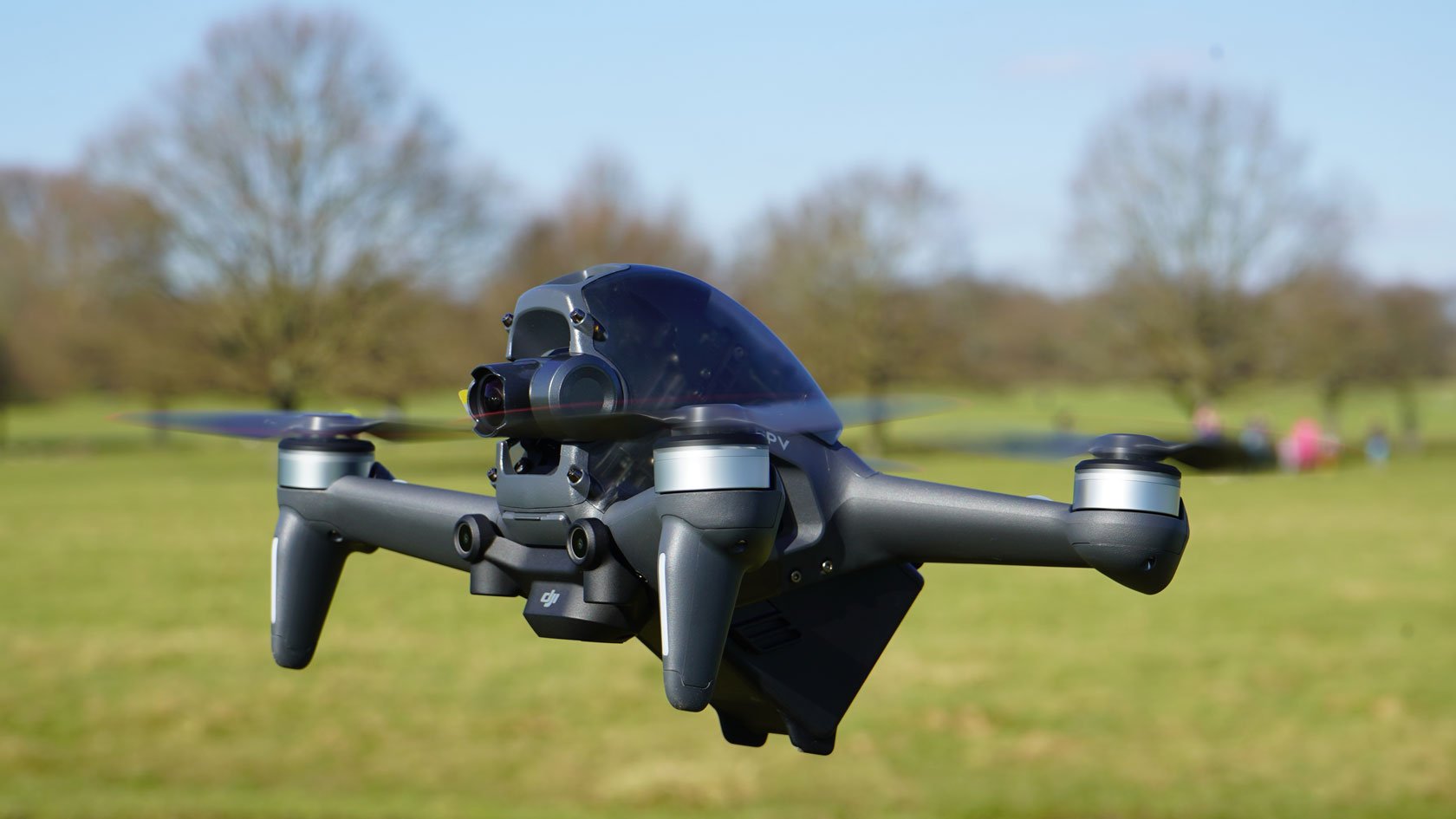DJI FPV review
-
-
Written by Adam Juniper
The FPV is DJI’s first drone designed for ‘first-person-view’ racing with goggles, while also sporting reasonable camera capabilities. Launched in March 2021, it’s been rumoured in one form or another ever since the first hobby drone builder saw the first Phantom. DJI have even come close, offering a pair of FPV goggles for the popular DJI Mavic Pro back in mid-2017. These were physically big, but not a huge success with the market; the FPV community seemed happier with low-quality but very responsive analogue signals than DJI’s Apple-esque high resolution displays and touch screen controls. The latency was about double that of analogue, not enough to convert FPV racers to using a Mavic Pro (with DJI’s digital transmission system), even though the image quality was stunning.
Another problem for the idea of a DJI FPV product was the economics; a lot of racers like to build their own drones, ordering motors online as soon as new ones become available. There is no waiting for consumer agency approvals and pilots want their drones light and cheap above all. Add to that the Drone Racing League seeming to get along without DJI, plus the global march of drone regulations making FPV flight tricky at the best of times, was there really a need for a FPV drone from DJI?
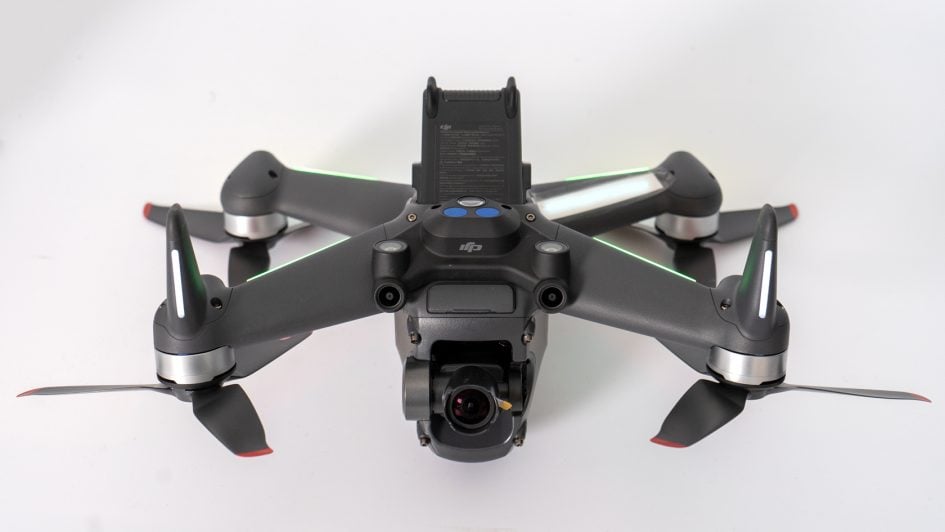
Until the announcement of the DJI FPV, I suspect most people thought not. We’d all seen DJI’s FPV Camera and newer, racing Goggles combination which could be attached to any drone by a pilot with a DIY-ethos. Now DJI have taken that last step into the FPV market with a ready-built aircraft that’s clearly built for speed first and capturing footage afterward. We don’t need to debate the possibility any more, so there are only really two questions left: who did DJI intend to persuade with this product, and do they pull it off?
So, what is it?
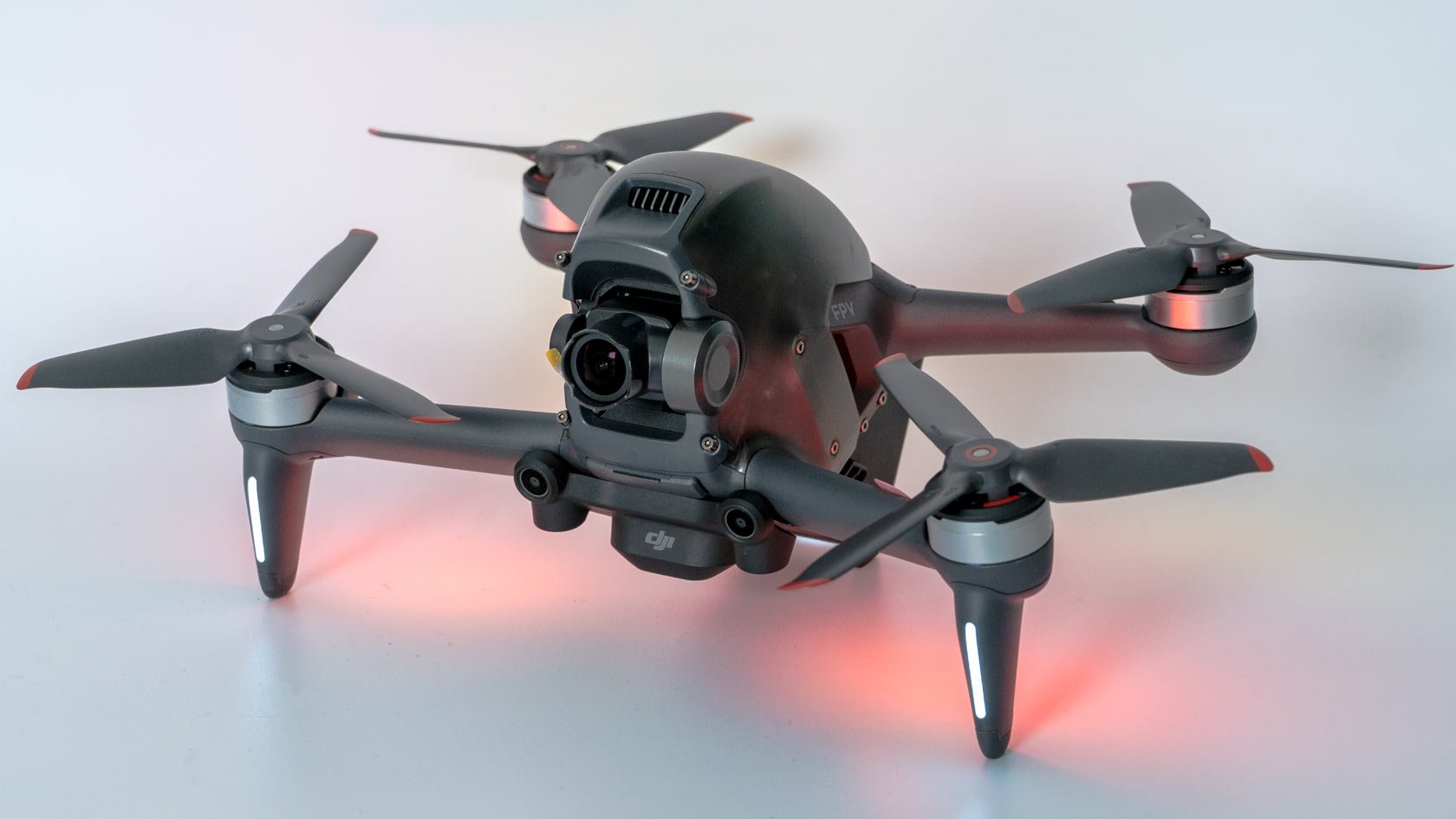
If you can imagine The Cat in Red Dwarf asking “So, what is it?” you’re asking the right question. On first inspection, it’s an FPV racing-style drone with more than a hint of the H.R.Giger when it comes to styling. It’s clearly built to fly forward quickly – the flying style of the racing drone – rather than the more hover-friendly aerodynamics of other DJI products like the Mavic and Mini. At the same time the camera is a 4K/60fps mounted on a stabilising gimbal which puts you in mind more of quality videography than a typical FPV drone. It’s more common for typical DIY drones to have their analog cameras fixed to the top at about a 45˚ angle.
Why the angle? So that once the drone is moving forward at best speed the view is more horizontal (the propellors are pointing down to maintain altitude and backward to push forward; turns are made by slight proportional changes in the prop’s relative speed). The community often mounts a GoPro or similar camera to capture their flight at best quality, not subject to the radio interference which affects the view through typical FPV goggles – this was what created the market for the GoPro Session.
DJI have clearly started out looking at a typical FPV drone, which are oft constructed onto a rigid carbon-fibre frame with motors, a flight controller and other components attached by the owner. Because of the X-shape nature of carbon-fibre frames, and the need for frequent changing, the most common solution for batteries is simply to strap them on with velcro (most pilots prize practicality over excessive expense or design, and beyond the angular basics, the speeds of the props make aerodynamic refinement of the craft somewhat moot.
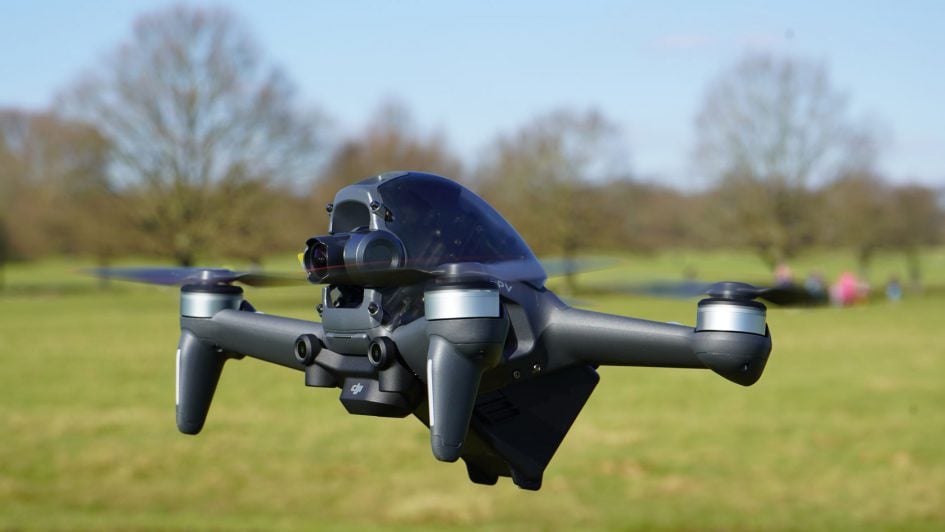
The X-shape is still apparent, but DJI have put a huge battery (capable of hovering over 12 minutes – an eternity in FPV racing) through the middle at an angle and the whole fuselage seems to be at about 30˚. When you put it down, it rests on legs from the front arms, and just on the battery at the back; odd at first, but perfectly sensible. Irksome but, again, very practical on a drone which must be built to survive a few bumps is the tough power connector at the top of the battery rather than DJI’s usual discrete contacts underneath.
So, it looks like a FPV drone, and it’s built a lot like one. The 3-blade props are very FPV and are push in and out with sprung clips – very good news if you’ve been following DJI’s patent difficulties in this area. But right in the middle the camera is on a gimbal, which definitely seems like an element too delicate for the rough-and-tumble of FPV acrobatics. It seems sensibly positioned, like it’d be hard to knock (the front props would likely strike any tree first, and there are spare props in the box), but it can’t be as robust as fixed camera, can it?
Tilt the front up a bit, and you’ll also see a number of sensors which definitely don’t look at home on a FPV drone. There are forward-facing collision sensors, and downward-facing ground sensors for a start. Inside there is a GPS and the drone can receive software updates via DJI’s phone apps; these updates include DJI’s safe flight location database which does make it a lot easier not to take off anywhere you shouldn’t.
Not for racer or photographer?
After all I’ve just said, you might well want to ask “So, what is it?” again, but in fact we’re a lot closer to an answer, and it’s one you can’t really understand until you’ve at least thought about what makes people choose the photography / videography or acrobatics drone they’ve selected. If you want great visuals, and you’re buying your first drone, then (given the most recent regulations) you should be looking at a DJI Mini 2. If you’re interested in getting into FPV for the fun, or for the ultimate speed goals, perhaps find your local flight club and think of it as a post-lockdown social activity. But, if you want to capture amazing footage from a moving camera, be able to try some stunts out, and know that – if you let go of the sticks – the drone will hover, just like a regular GPS drone, and you’re not too worried about cost, then you’ve found the right device here.
But you’re not going to impress the true Drone Racing League devotees for two reasons. Yes, the extra gear does add a bit of weight which will cost small amounts of manoeuvrability, but simply having it means you won’t have the ‘true piloting skill’. On the other hand, I tried operating in the safest ‘N’ mode and powering as fast as I could toward the ground and the drone didn’t crash, while I still felt the speed I was able to power through goalposts felt pretty impressive to me at least. It’s also good to know that, whatever mode you’re in, there is an emergency brake-and-hover button on the controller.
If you’re a filmmaker, though, imagine being able to offer the next emerging trend: motion aerials. You know, those scenes where the camera seems to be closely following a bird or presenting a bird’s eye view of some action while making tight turns and superhero-like ascents and descents? Admittedly you might find the props in camera if you’re flying with the kind of restraint your humble reviewer preferred, but the gimbal is adjustable as, of course, is the speed. Blast forward and the camera will point itself forward too, looking above the turning props. Alternatively you can use the finger-wheel on the remote to tip the camera down below the props during normal flights – a very familiar level of flexibility to those used to DJI’s other drones.
There are much cheaper ways to get familiar with the basics of FPV flight if piloting is all you want; indoor toys are actually often the best way as they’re unencumbered by regulation, they’re usually small enough to have tube-like guards around the props and yet the Mode-2 control principles (i.e. which stick goes which way) are typically the same. The difference is that you’ll have to get used to controlling the throttle yourself, a skill well worth mastering, whereas at least in the standard mode the DJI FPV is actually happy to hover without any control input. It will even return back to its point of take off when the power is nearing depletion or at your request. All useful features, but some like to set themselves greater challenges.
DJI FPV in operation
Getting a First Person View drone flying is ever so slightly more irksome than the same with a ‘traditional’ one. (Traditional, in this context, is the kind photographers have become used to. where a phone app serves as their FPV.) A separate battery is needed for the goggles, though thankfully DJI have settled on USB-C connectors to charge both their remote controller and goggle battery, at least at the device ends.
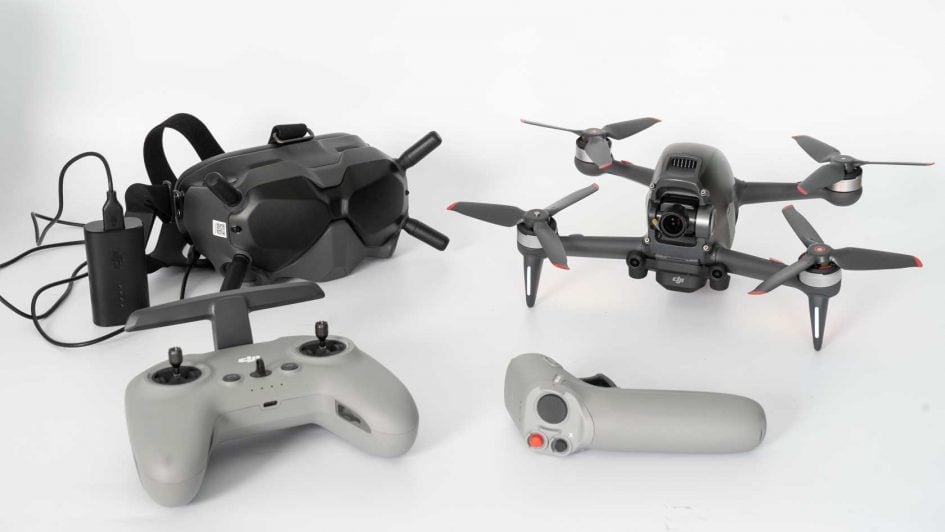
Once charged, the external battery for the goggles is disconnected from the USB to USB-C cable and connected again via that USB-C socket to a power socket. The eyepieces can be adjusted for width but (unlike the original DJI Goggles) not distance, though it was able to accommodate my eyesight as well as any other FPV goggles I have used.
Why an external battery for the goggles? Well tucking a battery into the strap that holds the goggles to the head is pretty standard practice in the FPV world, and operating with a pile of “li-pos” which fit both is convenient and relatively inexpensive. Other pilots might choose to give themselves a longer lead if they don’t want the weight of the battery on their head, and DJI seem to have picked up on that.
DJI, though, produce a different battery type for the goggles than the drone – one which seems like it’ll last through at least 5 flight batteries (very hard to reliably test with one review battery!) Though their aggressive styling looks a bit weighty, the headband is easy to adjust and fits many head sizes comfortably.
Similarly, once charged, the remote seems to have the power to keep going all day too. It’s nice that all the devices are powered up by DJI’s familiar short-press-long-press, but a bit of a shame that the buttons are in inconsistent places and, to be honest, having a dangling battery for the goggles also seems to pose some fashion constraints (you’ll need a corresponding pocket).
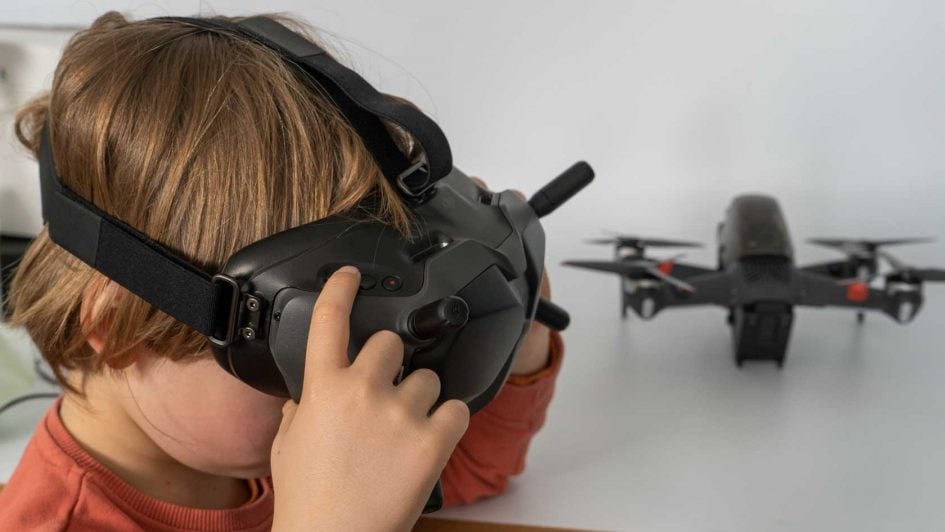
On the plus side, it’s hard to fault the way the drone works when powered up according to the quick start guide; even without a phone connection it seems capable of checking whether you’re in a flight warning areas and, once you get used to the mini-joypad style finger button at the top right of the goggles, the idea of FPV won’t feel strange. Remember, though, that in most places you are required to have someone with you to keep their uncovered eyes on the wider sky. Securing this exemption was a real win for the FPV community and it shouldn’t be abused.
What is the DJI FPV like to Fly?
One you’ve overcome the practicalities – which aren’t significantly more challenging than other drones – and picked a safe spot, it’s time to get flying. FPV flight is much more about the joy of (strongly) powered flight, so pick a spot with plenty of space, then when you power up – even in ‘N’ mode (recommended for your first flight) – you’ll find plenty of power is available very promptly. On the other hand, the GPS, an altitude sensor (barometer), and an attitude sensor are working by default, so you can just take off and hover if you like. This is not a sensible use of battery – but the option of letting go of the sticks without crashing is an option I find rather comforting to have since it’s the norm on camera drones.
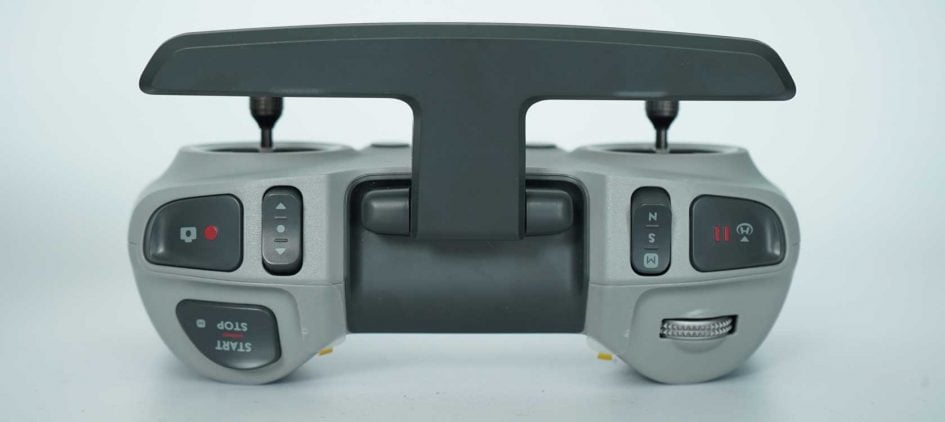
When I switched up to ‘S’ I was amazed how much speed was suddenly available to me without losing the advantages afforded to me from flying this way. My nervousness at the potential harm I could do (beaten into me by aviation-authority approved training) was beginning to take a back seat to the obvious sense of fun that everyone else clearly experiences when flying FPV.
If I went for a power-dive, I found the machine seemed to have a strong sense of self preservation; I could head down but in the last meter or so before the surface the drone would back off from the ground hard and either skim or avoid the surface (keeping a meter / few feet away in ‘N’ mode).
On my second flight I was already pushing this drone much more than anything from DJI and feeling safe but not too safe) doing so. Plus, I knew there were some more settings there for me when I wanted to pursue the limits of the machine.

Dive and rapidly climbing are in many ways more stunning than the other aspects of the flight; it is this in which the shackles seem to have been completely removed, and the speed in which you can hit 120m (or your chosen limit) is eye-watering. The more fun you’re having, the more you need to be mindful of the speed you’ll power through the battery; FPV is not about carefully managed half-hour flights but getting the most entertainment that 2000mAh offers (that’s 6S 22.2 Volts) and the more you rip through the sky, the faster you’ll see that battery meter in the bottom-right of the screen count down.
DJI, incidentally, suggest that under best (i.e. most boring) conditions, a continuous forward flight at 25mph (40kph) can keep the flight battery running for 20 minutes absolute max. In my most restrained test (and I must admit I found a bit of play impossible to resist), I recorded 15 minutes of flights. Range-wise, as ever, the controller will work at many multiples of the legal limit, at 6Km in UK/EU or 10Km in the USA.
It’s worth noting that you can tweak the controller settings via the menu, just like a more traditional FPV drone. You also need to use the menu to enable ‘real’ manual (the M setting is also set to behave like DJI’s Sport mode by default, which will likely save a a lot of these quads since full manual will disable all the auto-hover functionality that folk like me are that bit too used to). That custom M mode allows adjustment of Gain and Expo and the attitude limits can be disabled for the so-called real pilots.
Motion Controller
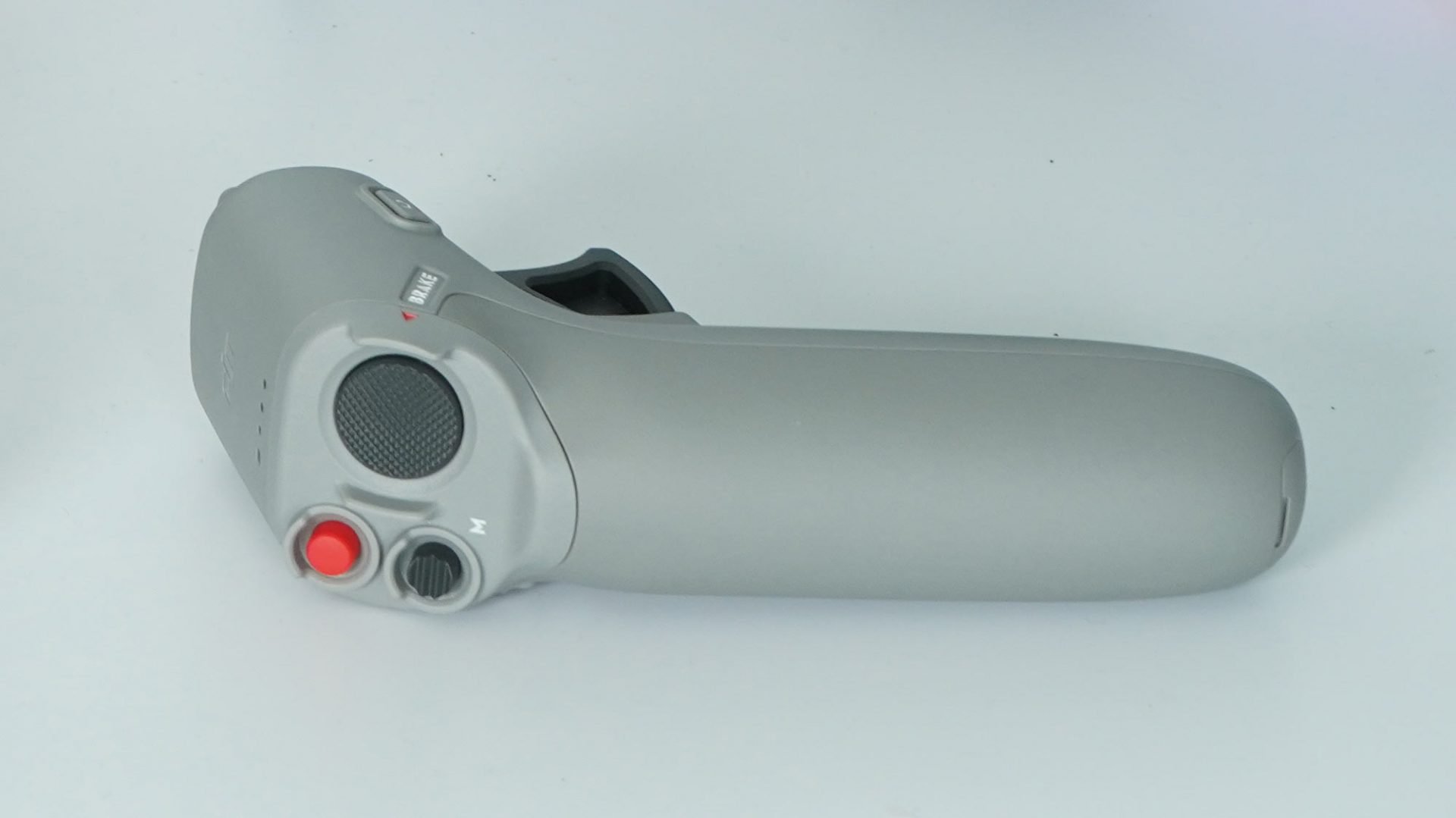
Watch this space – a new controller has arrived for us to test. It was rumoured, but now we know it’s real. Can it possibly beat the sticks? Personally it’s not for me, but I can see the appeal; the drone can be powered up with a double tap, then will fly toward a small circle on the FPV screen which you can move up/down/left/right by turning your writst. I can’t imagine it ever feeling quite as solid as the sticks, but I’m an old man now and it represents change!
DJI FPV Image Quality
Having suffered my way though traditional FPV, I can say DJI’s 60fps system is a revelation, recording 4K/60fps to the on-board camera and returning an uninterrupted video of HD standard to my goggles in my limited test flights. I’ve got to admit that I didn’t fly behind too many thick obstacles in the course of my testing (safety first) but given DJI’s HD FPV system has a couple of years under its belt and was warmly received at launch I feel confident saying this area isn’t an issue.
Recording requires an A2 Micro SD card (like an Extreme Pro) and a ‘mere’ Class 10 doesn’t cut the mustard. I only had one of these, so I put it in the drone – the video I saw on the other card in the goggles was not so good but to be fair I did get a ‘Slow SD’ warning.
The camera sports a 150˚ field of view, so pretty wide angle (14.6mm EFL, since you ask) and a 1/2.3″ CMOS sensor with an ISO range of 100-12,800 which is adequate. 1/60 sec is the slowest possible shutter speed (an insult to those shooting with PAL settings) and 1/8000 the max. It is appreciated that these can be fixed manually though the default is a well-balanced auto which understands that a lot of your view will often be the sky (but can very quickly change with hard manoeuvres).
Recorded Video Quality
The video output – the 4K recorded to the card in the drone – is of good quality where there is decent light. In my limited testing time, I flew on one very sunny day and the results looked much like the still you can see below, while in the early evening, or morning lit through cloud, the video was good but it seemed apparent the 60fps smoothness had perhaps created a bit of noise.
That said, the video seemed to cope well with challenging light, like turning into the sun. There is a propellor flicker compensation system, set to Auto by default which also seemed to work better than most FPV systems I’ve seen (though not absolutely flawlessly). Less convincing, at least on the cloudy morning, was the image Distortion Correction, though it did crop the propellors off it seemed to be at the expense of slightly softer recorded 4K. Nonetheless it’s nice not only to have it as an option but to be able to choose for Goggles, Drone Video or both.
In fact the menu (accessed via ‘Camera’ in ‘Settings’) offers a good choice of recording settings, shake correction, auto-record on take off (I urge you to turn this on), choice of H.264 or H.265, Normal or D-Cinelike, Roll correction (as opposed to lens distortion) and more. You can also set the camera to 4K/50fps and 1080P/120fps among others if you prefer.
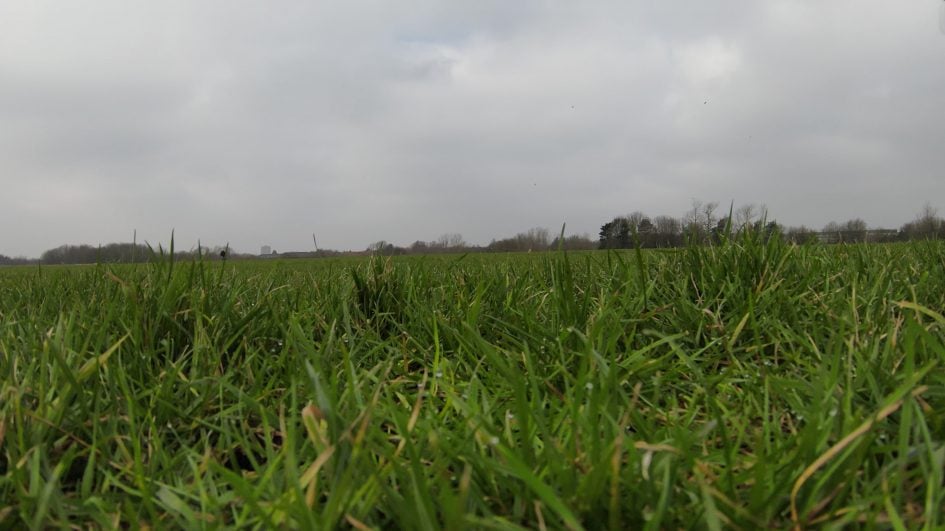
Still Image Quality
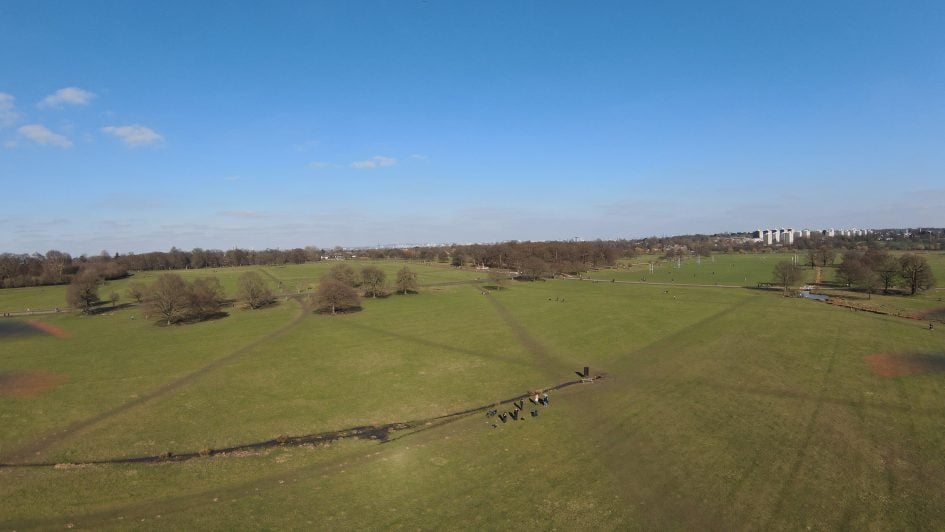
That said, capturing a still image seems a bit of a strange thing to do if you are trying to tear through the sky in cool and exciting ways. You have to stop recording your 4K video feed to try and use the same button as a camera shutter option. It might be better to think of grabbing some stills later or just accept that this isn’t really what this machine does best. That said, at least it can, and you can easily re-direct the camera angle too.
Summary
So, at the start I repeatedly found myself asking “What is it?” but after a few flights of a review model I can comfortably say it’s something I want more of in my life. It’s expensive, and it’s too heavy for kids (795g take-off weight) and it doesn’t feel like the ideal first drone, but it makes a great way of transitioning into FPV in a way which isn’t too much of a culture shock for people with a background like me (Parrot A.R.Drone and upward). In fact the more I think about this, the more it feels like FPV for me.
That isn’t without its problems; it’s not the easiest of expenses to justify post-pandemic, and DJI’s ‘Intelligent’ batteries pose two problems. Firstly they add to the cost (you need more than one, no question) and secondly, the more ambitious you get in the air, the briefer the battery life disappears. Lastly there is the ever-growing hostility of legislators to all aircraft over 249g at the same time as things are actually getting a little easier below that threshold. That’s not DJI’s fault, of course, but it does mean you should think carefully before treating yourself.
Ultimately, though, this device offers a great combination of excitement and quality which could have real potential capturing new moving video clips for action sequences or being an expensive but exquisitely designed centrepiece for parent-child bonding. If you’re a hardened FPV pilot already, you’re going to find this tempting (though you’ll never admit it) but in truth it’s the ideal device to recommend to your interested friends. They don’t want to DIY, they don’t trust analog FPV, and they’ll massively benefit from the ability to step through ‘modes’ (essentially difficulty levels) without a catastrophic first time out.
